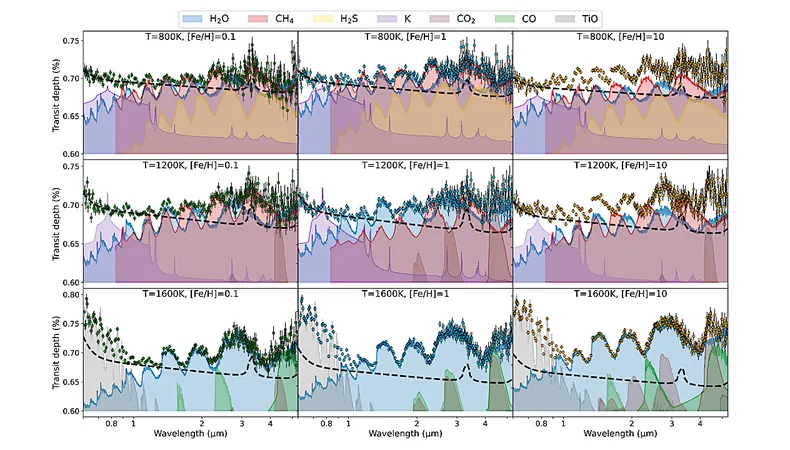
Revolutionary Research Unlocks Secrets of Water on Exoplanets!
2024-11-14
Author: Olivia
Groundbreaking Study by Cornell University
In a groundbreaking study, scientists from Cornell University have embarked on a mission to unravel the mysteries of exoplanets by focusing on the chemical processes found in the Earth's own hot mantle. This innovative team has developed a library of basalt-based spectral signatures that could potentially reveal the presence of water on distant worlds beyond our solar system.
The Role of Basalt
Esteban Gazel, a prominent professor of engineering at Cornell, explains the significance of basalt, a gray-black volcanic rock prevalent throughout our solar system. "When the Earth's mantle melts, it produces basalts, which provide key insights into geological history," Gazel stated. His research emphasizes that similar processes occurred on Mars and the Moon, where basalt formations dominate the landscape.
Utilizing JWST Data
The researchers aim to utilize data from the James Webb Space Telescope (JWST) to probe the geological make-up of exoplanets. In their recently published study in *Nature Astronomy*, co-authored by Emily First, a former Cornell postdoctoral researcher now assistant professor at Macalester College, they outline the potential for observing the geological diversity of rocky exoplanets using mid-infrared spectra.
Insights from Basaltic Lava
Gazel reassuringly notes, "The majority of exoplanets are predicted to produce basalts, influenced by the metallicity of their host stars. When these planets’ mantles melt, the resulting lavas will predominantly be basaltic—an occurrence likely universal across the galaxy."
Measuring Spectral Signatures
In exploring this, First meticulously measured the emissivity of 15 basaltic samples to identify the spectral signatures that the JWST's mid-infrared spectrometer may detect. Once basaltic lava cools on an exoplanet, it solidifies into rock that could interact with water, enabling the formation of hydrated minerals. Scientists are particularly looking for signs of minerals like amphibole or serpentine, which can indicate past interactions with water.
Challenges in Detection
But detecting water on exoplanets is not an immediate task. It requires considerable time, as the JWST orbits nearly a million miles from Earth and may need dozens to hundreds of hours just to gather data from one star system located light-years away.
Case Study: LHS 3844b
The research team also focused on LHS 3844b, a super-Earth identified about 48 light-years from Earth, analyzing its potential basaltic characteristics. Ishan Mishra, working with Nikole Lewis, associate professor of astronomy, created computer models to simulate the spectral data First collected, predicting how various exoplanet surfaces could appear to the JWST.
Innovative Tools for Exploration
Lewis highlighted the innovative use of previous modeling tools, stating, "Ishan's coding tools were initially developed to explore icy moons in our solar system, and now we aim to apply those insights to exoplanets."
Broad Objectives of the Research
While the study's focus wasn't exclusively on LHS 3844b, First emphasized their broader objective: "We wanted to explore a plausible range of basaltic rocky exoplanets that JWST and other observatories can study in the coming years."
A Shift in Exoplanet Exploration
Notably, this research signifies a shift in exoplanet exploration, where scientists are moving from analyzing single data points of chemical evidence to examining multiple mineralogical components. By delving into signatures related to mineralogy and bulk chemical composition—like the quantities of silicon, aluminum, and magnesium—geologists can gain deeper insights into the conditions that formed these celestial rocks.
The Future of Water Detection in Exoplanets
As scientists continue to refine their methods and tools, the prospect of detecting water on exoplanets brings us closer to answering the age-old question: are we alone in the universe? With each discovery, the tantalizing possibility of life beyond Earth appears to edge closer to reality! Stay tuned as we uncover more about the cosmos and our potential interstellar neighbors!









 Brasil (PT)
Brasil (PT)
 Canada (EN)
Canada (EN)
 Chile (ES)
Chile (ES)
 España (ES)
España (ES)
 France (FR)
France (FR)
 Hong Kong (EN)
Hong Kong (EN)
 Italia (IT)
Italia (IT)
 日本 (JA)
日本 (JA)
 Magyarország (HU)
Magyarország (HU)
 Norge (NO)
Norge (NO)
 Polska (PL)
Polska (PL)
 Schweiz (DE)
Schweiz (DE)
 Singapore (EN)
Singapore (EN)
 Sverige (SV)
Sverige (SV)
 Suomi (FI)
Suomi (FI)
 Türkiye (TR)
Türkiye (TR)